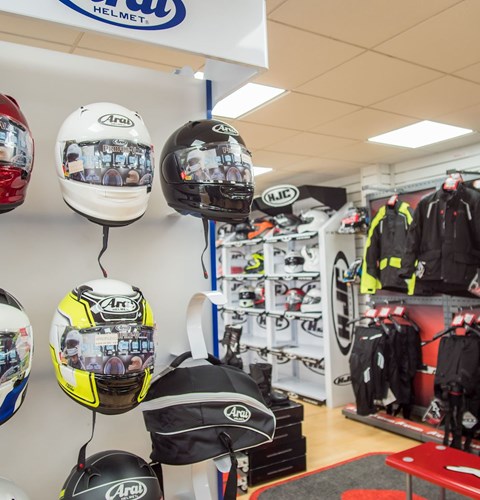Explore the Latest Motocross Gear NZ for Every Degree of Rider
Explore the Latest Motocross Gear NZ for Every Degree of Rider
Blog Article
A Thorough Appearance at Motorbike Parts: What Every Rider Ought To Know
A thorough understanding of motorcycle components is not simply valuable yet essential for any biker intending to take full advantage of efficiency and safety and security. Each component, from the engine's detailed operations to the reliability of brake systems, plays a pivotal function in the general experience and functionality of the bike.
Understanding the Engine
The engine, typically pertained to as the heart of a motorcycle, is a complicated setting up of components that work in harmony to transform fuel right into activity. At its core, the engine's primary feature includes the burning process, where air and fuel mix and stir up within the cyndrical tubes, causing regulated surges that drive the pistons. These pistons move up and down, transforming chemical power into power, which ultimately transforms the crankshaft, eventually powering the bike.

Comprehending the intricacies of a motorbike engine is essential for fanatics and cyclists alike. It not only supplies understanding into how motorcycles achieve their outstanding power and rate however also aids in efficient maintenance and troubleshooting, making sure longevity and dependability when traveling.
Suspension Systems
While the engine powers the motorbike, the shock absorber plays a vital function in making sure a controlled and smooth experience. The shock absorber is accountable for soaking up shocks from the road surface, preserving tire contact, and offering stability during cornering and braking. It makes up 2 major elements: the front forks and the rear shock absorbers.
Front forks are usually telescopic, wetting and consisting of a spring device. The springtime compresses and prolongs to take in bumps, while the wetting device regulates the activity to stop extreme jumping. This mix makes certain the front wheel continues to be in call with the roadway, using remarkable handling and convenience.
The rear suspension, generally a monoshock or twin-shock arrangement, works likewise to the front suspension but is customized to sustain the bike's weight and motorcyclist - motocross gear. It handles rear wheel motion, adding to the bike's total equilibrium and responsiveness
Shock absorber can be adjustable, permitting riders to adjust preload, compression, and rebound setups according to individual preferences and riding conditions. This adjustability boosts efficiency by maximizing the motorbike's interaction with varied terrains. In summary, an effective shock absorber is critical for biker comfort, safety and security, and the bike's handling prowess.
Brake Components
Quiting power is a basic aspect of bike security, and it depends upon the efficiency of the brake elements. The primary aspects of a motorbike's stopping system consist of the brake pads, calipers, blades, and master cyndrical tube. motocross gear. Each of these parts plays a vital function in making sure efficient braking performance
Brake pads are necessary as they create the required rubbing versus the rotors to slow down or quit the motorbike. Built from products such as sintered metal or natural composites, the option of brake pad material dramatically affects efficiency and longevity. Calipers, real estate the brake pads, apply pressure to the pads when the brake lever is involved, helping with call with the blades.
The rotors, usually made from stainless steel or actors iron, are installed to the wheels and act as the surface versus which the brake pads press. Their style, including size and thickness, impacts heat dissipation and stopping power. The master cyndrical tube, attached to the brake bar, generates hydraulic stress transmitted through brake lines to the calipers, guaranteeing constant stopping pressure.
Regular maintenance and assessment of these elements are essential for ideal performance, preventing wear and guaranteeing motorcyclist safety and security when traveling.
Tire Basics
Beyond preserving robust braking systems, making certain ideal tire performance is similarly significant for motorbike security and efficiency. best budget helmet Tires are the single contact factor in between the bike and the roadway, making their problem crucial in taking care of, stability, and total trip quality.

Additionally, consider the tire's age. Rubber substances deteriorate over time, also if step appears ample. Check the sidewall for the DOT (Department of Transportation) code to ascertain the tire's age. Normally, substitute is recommended every five years, no matter wear. Spending attention in these tire essentials not only enhances efficiency however likewise significantly enhances riding safety.
Electric Equipments
In the realm of motorcycle maintenance, the electric system plays a vital function in making certain reputable performance and motorcyclist security. This complex network encompasses vital elements such as the battery, generator, starter electric motor, and wiring harness. Each element is important for the smooth operation of the motorcycle, from ignition to illumination and interaction with various sensing units.
The battery serves as the heart of the electric system, providing the necessary power to start the engine and operate devices. Frequently checking the battery's voltage and terminals for corrosion is important to avoid unanticipated failures. The alternator, on the other hand, reenergizes the battery while the engine is running, making certain a continual power supply.
To preserve it, bikers should pay interest to any kind of unusual noises or problems throughout startup. Guaranteeing that the cables are free and intact from damage is important for ensuring and protecting against short circuits capability.
Conclusion

Stopping power is a basic facet of motorbike security, and it hinges on the effectiveness of the brake elements. The primary aspects of a motorcycle's braking system consist of the brake pads, calipers, rotors, and master cylinder.Brake pads are important as they create the necessary friction versus the blades to slow down or stop the motorbike.Beyond maintaining robust stopping systems, ensuring optimal tire performance is equally substantial for motorcycle security and performance.In the world of bike upkeep, the electric system plays a crucial duty in making sure trustworthy efficiency and check cyclist safety.
Report this page